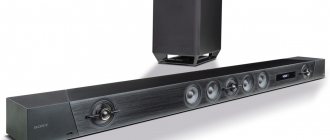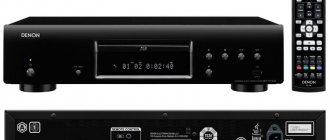Do I need to purchase receivers with Dolby Atmos and DTS:X?
The latest surround sound standards, Dolby Atmos and DTS:X, allow you to create a fully three-dimensional sound environment with sound around and above you. To take advantage of this opportunity, they are now even mixing and updating music previously recorded in stereo. If the Wi-Fi AV receiver supports Dolby Atmos and DTS:X and speakers of the appropriate configuration are connected. This will be a significant improvement over standard 5.1 surround sound.
Dolby Atmos is the more common of these two standards, from popular movies on 4K Blu-ray to TV shows and series on Netflix, HBO, Amazon Prime Video and Disney Plus. DTS:X is currently only available on 4K Blu-ray discs.
How many channels should you choose?
Dolby Atmos AV receivers in the entry-level price range most often offer seven channels of amplification. Among them are five for standard left/center/right and two rear speakers for surround sound, as well as two additional channels playing into the ceiling. This circuit is called 5.1.2 (.1 is a dedicated subwoofer channel). More expensive AV receivers contain nine or even eleven amplification channels.
Often, budget AVRs are offered without Atmos and are still capable of high-quality 5.1 surround sound. Regardless, Atmos is worth paying more for, even if you don't have enough space in your room for a full 5.1.2 or 7.1.2 option. There are more and more small Atmos speakers on sale, so they don't have to take up a lot of space in the room.
The importance of power and how many watts per channel are required?
If you have a small room, you don't have to worry about how many watts per channel your AV receiver provides. If the room is large, you may need a fairly powerful device for high volume. You will have to buy larger and more expensive AV receivers that can convert the power into high volume for all connected speakers.
Manufacturers' claims regarding the power of their products should not be taken too seriously. You cannot verify the numbers presented and manufacturers use different measurement techniques. They may indicate the maximum output power when only one speaker is running, which is not indicative for a surround sound system. It is advisable to read the fine print.
How many HDMI inputs and outputs are required?
Models in the entry-level price category will most likely have four HDMI inputs, while more expensive ones will have at least twice as many. In this case, the more the better. Also check the number of HDMI outputs on the AV receiver. If there are two of them, you can connect a TV and a projector at the same time.
All AV receivers support ARC (Audio Return Channel) or the more modern eARC (Enhanced Audio Return Channel) standard. A single HDMI cable, when connected to the appropriate ARC-enabled connector on your TV and AV receiver, can transmit audio and video in both directions. If you have multiple sources connected to the HDMI inputs on your TV, the audio will be sent through the AV receiver (if your TV also supports ARC).
How to choose an AV receiver
There are several main characteristics that you should pay special attention to when choosing an AV receiver:
- Power. The higher the better. However, for a room of 18 square meters, 80 watts and an acoustic sensitivity of about 90 dB are suitable. For 30 m² there are already different numbers - 120 W and 95 dB, respectively.
- Digital-to-analog converter. Look at the frequency in kilohertz, the higher it is, the better. On average, this figure is 96 kHz, the most expensive models have a frequency of 192 kHz.
- Convenience. Pay attention to the menu so that it is easy to operate. Otherwise, the AV receiver will turn into a puzzle.
Modern devices. The latest models of mid-price and premium AV receivers are equipped with a Bluetooth interface. The receiver is easy to synchronize with any device - smartphone, home theater, TV, laptop, etc. And enjoy the sound of your favorite compositions in the highest quality. A remote control is also often included.
What other functionality should you pay attention to?
HDMI eARC is a more modern version of the legacy Audio Return Channel (ARC) standard. It supports audio pass-through without loss of quality, allowing you to transfer modern audio formats, including Dolby Atmos and DTS:X. It also offers more reliable synchronization of audio and video. In the old ARC standard, sound and lip movement did not always match.
If you have a high frame rate TV for video games or any other content, you will need 4K HFR (High Frame Rate) support.
The HDMI 2.1 standard contains a number of technologies for next-generation game consoles. In particular, Variable Refresh Rate ( VRR ) helps avoid screen tearing in video games. Fast Frame Transfer ( QFT ) helps reduce latency. Automatic Low Latency Mode ( ALLM ) does not play a particularly important role, but it provides an opportunity to save time. It automatically activates the TV's special gaming mode if a game console is connected to it.
Higher-priced AV receivers offer more advanced surround correction or Room EQ technologies, such as Audyssey or Dirac . They use a microphone to listen to test signals in a room and process the results to balance the different channels and optimize the sound quality to suit your room. This can have a noticeable impact on sound quality.
Microphone for Audyssey system
Mid- to high-end audio systems may require an AV receiver with the ability to connect to a preamp output. This makes it possible to route different audio channels to an external power amplifier and provides direct connection to active speakers. The result is less load on the AV receiver and allows for more precise control of fewer speakers. It also becomes possible to add additional surround channels to AV receivers with a limited number of internal amplifiers.
Popular questions and answers
Sound engineer and production manager Nikolai Fedenev answered questions from Komsomolskaya Pravda.
What parameters should you pay attention to first?
Choosing an AV receiver is a very important process, because it is a device that (most likely) will stay with you longer than the TV and other multimedia equipment in your home. Don't skimp on the receiver; buy with the future in mind. The power should be chosen a little higher than that of the speaker system: excess is better than deficiency. Try to have a little more inputs than the number of devices you currently have: you never know when you'll get a new player, right? Try to choose a receiver with automatic sound correction and surround adjustment - this way you will get the result that was intended by the sound engineers of musical groups and film studios.
How is an AV receiver different from an amplifier?
A home amplifier is usually a device with a smaller set of functions. The receiver is always equipped with a system that supports surround sound (5.1; 7.2, etc.), as well as the maximum number of required connection interfaces (HDMI, S/PDIF, Bluetooth, etc.).
How to connect an AV receiver to a TV?
At the moment, the main connection method is the HDMI interface. It is very important that its resolution is compatible with your TV. You should not connect a Full HD receiver to a 4K TV - this way you will not achieve maximum image quality. If you want your TV to work as an audio source, you need to connect it to the HDMI (ARC) connector.
How to connect an AV receiver to a computer?
To connect the receiver to a PC or game console, it is recommended to use the optical digital S/PDIF connector. This way you will get the surround sound of a real home cinema.
Best entry-level AVR: Sony STR-DH790
The Sony SRT-DH790 resembles a simplified version of the STR-DN1080. It is 25mm lower than the older model, so it can fit into more AV systems. It has an output power of 145 W vs. 165 W, HDMI inputs and outputs 4 and 1 vs. 6 and 2, and uses spring-clip terminals for the center, surround, and rear/height speakers instead of the more universal banana sockets. There is also no built-in network support. In general, as the price decreases, so do the possibilities.
- Dolby Atmos : yes, 5.1.2
- Output power : 7 x 145 W
- HDMI : 4 inputs, 1 output
- Dimensions : 430 x 297 x 133 mm
- Weight : 7.4 kg
Prices for Yandex.Market
Sony STR-DH790
Best Mid-Range Atmos Receiver: Denon AVR-X2700H
This model supports 8K TVs, 4K video sources at 120 fps and an adjustable refresh rate. This provides future-readiness, including readiness to work with PlayStation 5 and Xbox Series X gaming consoles and streaming services at 8K resolution. Only one port supports HDMI 2.1, but the others also support VRR, ALLM and QFT, and the HDMI outputs support eARC.
There's Dolby Atmos (including Atmos Height Virtualization), DTS:X (with DTS Virtual:X) and four major HDR formats. As you can see, there is very little that this AVR cannot handle. Just as importantly, it all looks very easy thanks to the excellent automatic calibration process. The speakers are self-configuring , and the simple interface makes it easy to control via your TV.
All that remains is to include high-quality content and the sound quality will not disappoint. Fire up 4K Blu-rays of films like Blade Runner 2049, Avengers: Endgame, Star Wars: The Rise of Skywalker, and tune into Disney+ to experience gorgeous audio and superb precision control of sound effects, putting you right in the middle of the action. Only in the best cinema you can get a similar experience. The effects of the virtual speaker are shown very convincingly, so as not to remember the absence of Atmos speakers, although if there is at least one such speaker, the effects will be even more convincing.
The music quality isn't too bad either, although it's worth trying to switch between different sound modes to find the best one for your room. There's built-in Wi-Fi music streaming and multiroom functionality controlled via the Denon HEOS . It all adds up to a superb AVR that will be your home theater staple for years to come.
- Dolby Atmos : yes, 5.1.2
- Output power : 7 x 150 W
- HDMI : 6 inputs, 2 outputs
- Dimensions : 433 x 330 x 167 mm
- Weight : 9.5 kg
Prices for Yandex.Market
Denon AVR-X2700H
What it is
When the first FM radio stations with stereo broadcasting appeared, the problem arose of outputting channels, left and right, to an amplifier and speakers.
After all, most of the radios did not have a built-in stereo amplifier, much less an equalizer. The problem was solved with the help of special decoders - receivers that isolated channels from the receiver, sending them to amplification equipment. But when other sources of media files appeared that required processing of audio channels, personal computers, Blu-ray and DVD players, projectors, the problem became more serious. Since each component required its own decoder capable of outputting audio and video tracks, matching, processing them and outputting them to speaker systems, televisions, and projectors. Audio-video receivers with a built-in DAC (digital-to-analog converter) could partially solve such problems. They, as the name implies, converted digital signals into analog and then output them through acoustic systems (speakers), video projectors, and televisions. The advantages of this scheme are separate power per channel of each source. This solution allowed, and still allows, to obtain high output power of each channel of the audio-video information source. The disadvantages of this connection are that each source requires its own decoder, plus a large number of cables are required.
Therefore, AV receivers were created that have several microprocessors and allow simultaneous processing of several channels of audio and video files from several sources. At the same time, popular decoder models are not only capable of processing and transmitting AV tracks to the speaker system, but also processing information. For example, highlight a separate channel, improving its sound, improve image quality (scaling), decode an analog signal into a digital one in order to transfer it to a computer or other computing equipment via HDMI interfaces. And of course, such devices come with a radio tuner, although according to buyers this is more of a tribute to tradition.
What are the audio formats?
It was the advent of stereo sound not only on cassettes, vinyl discs, but also on FM radio stations, television, and over time on Internet files that created the AV receiver. Standard: 5.1, 5.2, 7.1, 7.2, 9.2, 11.2, 13.2, often found when describing a decoder, indicates the number of front speakers and bass (subwoofer). Let's look at these designations, or rather types of sound formats, in more detail:
- 5.1 is without a doubt the most common sound format, which is often used by inexpensive speaker systems, computers, and laptops. The number indicates the number of front speakers (four pieces, two in front of the listener, two behind), and the number of subwoofers. In this case, there is only one, usually installed in the center. But to avoid mistakes when choosing this format, you should take into account that its implementation requires specialized audio outputs. And laptops, as a rule, come with a 3.5 jack (mini jack) or a USB port. In this case, all channel files are simply scattered onto the left and right speakers, which is why most of the user’s audio ambience effect is lost. To implement the 5.1 format, you need a good sound card with a decoder.
- Dolby Pro Logic is ideal for inexpensive systems, as it essentially emulates multi-channel audio. That is, from two stereo channels, left, right, a semblance of a set is created which is then reproduced. Although such multi-channel playback is purely conditional, it can be used for a budget TV.
- Dolby Digital EX, DTS-ES, THX Surround EX – use 6.1, 7.1 audio channel scheme. They are combined with the above 5.1 format using specialized software.
- Dolby TrueHD, DTS-HD, DTS-HD Master Audio - perfect for those who want to get not only surround, realistic sound, but also for recording via Blu-ray media.
- DTS Neo:X, Dolby Pro Logic IIz - create twelve-channel sound, taking the six-channel format as a basis.
- DTS:X, Dolby Atmos is the most progressive format for home cinema, taking into account the features of modern film sound recording. Previously, when shooting films, all sounds were divided into channels, for example, stereo is a left, right channel, more modern sound recording systems had a larger number of channels. Nowadays, sound separation does not occur along audio channels, but is tied to film objects. Which requires more channels and, accordingly, more speakers capable of reproducing film objects. Thus, the number of channels of these formats can reach 64.
- Auro 3D is the most commonly used format to reproduce 3D audio. But, like the formats mentioned above, to get full sound you need a specialized speaker system with speakers located, including on the ceiling. Which will require a large room.
What to look for when choosing an AV receiver
Theoretically, the AV decoder can be divided into two parts, audio parameters and functionality for connecting equipment. Among the sound characteristics, the most important are:
- Sampling frequency - shows the frequency that the decoder processor converts to analog for further playback through the speakers. The higher the parameter, the more realistic the sound will be. But sometimes a high parameter will simply not be in demand, so the recommendations of experts are to choose BL devices whose frequency is about 96 kHz.
- Audio bit depth is the ratio of the bit depth of the device’s processor and the recording being processed. The minimum number should be 24 bits, but this is the minimum that budget models have.
- Nonlinear distortion factor is the ratio of the introduced harmonic amplitude to the amplitude of the useful signal. A high level of NI will negatively affect the sound, especially if it is high-frequency.
- Signal-to-noise ratio - when connecting external devices, third-party interference is inevitable, which then takes the form of noise. Therefore, high-quality sound begins when the useful signal to noise ratio is not lower than 90 dB.
The functionality of the receiver is also affected by the versatility of connecting the device. The more ports, the more components, such as players, TV, computer, speakers, can be connected. Mandatory ports are:
- Linear inputs/outputs (paired jack/RCA connectors) – used to connect analog audio sources. These connectors provide the power of the front channels, but the manufacturer often does not provide a power channel for the subwoofer. Then choose an active type subwoofer or you will have to buy an amplifier for it separately.
- USB port – digital information is transmitted through it. But when using the USB Type B interface or similar ones, you should remember about the supported formats, especially when it comes to external media. So, the FLAC format allows the most complete music to unfold, but such varieties as WAV, DSD (DXD) AIFF, M4A compressed type are used.
- HDMI is also used by digital media, allowing more complete transmission of audio and video signals. It is through this interface that 4K signal is supported.
- S/PDIF is an analogue of the HDMI interface, which has its advantages and disadvantages. Disadvantages include bandwidth, 1.5 Mbit/s versus 25 Mbit/s for HDMI. The advantage is that when using an optical cable, the device’s noise immunity is higher.
- DLNA, RJ-45 – connect to the network via Ethernet, providing access to online audio resources or a film library. Another, wireless option, is provided by models with Wi-Fi format.
How to choose the optimal model
The peculiarities of choosing digital converters are such that users often have to overpay for unnecessary functions. Therefore, first of all, you should decide on the purpose of the purchase and the available space for a home theater. Since the full effect of presence or 3D environment can only be obtained in a large room where speakers will be located around the perimeter, including the ceiling surface. But then another problem arises: it is very difficult to manually configure such a number of columns. After all, all the nuances of sound can be felt with the correct placement of the speakers, the listener himself.
Therefore, expensive receivers are equipped with automatic calibration systems that operate without user intervention. They also think about the location of the receiver itself, because it is a semiconductor device, and heat removal is required during operation. Popular companies install active cooling systems and coolers in their new products. However, most models still have a passive system, which requires a lot of space without blocking the duct openings.
Which company is better to choose?
Advice on choosing such complex, expensive equipment, of course, cannot do without recommendations from manufacturers, on whom the durability and functionality of the equipment depends. The best manufacturers of such equipment are:
- Pioneer Corporation is an international corporation that began its activities at the beginning of the 20th century. The company's scope of activity is wide - from large home theaters to peripheral equipment. The company's products represent the best value for money at the moment.
- Marantz is an American company created at the dawn of the 50s of the last century. The company's pricing policy is focused on the production of premium-level equipment with high technical characteristics.
- Sony is another Japanese manufacturer whose products always top the ratings of quality electronic devices. A distinctive feature of the company is its own developed technologies, which make its equipment unique at an affordable price.
Best Slim AV Receiver: Marantz NR-1711
The Marantz NR-1711 has many of the advantages of the Denon AVR-X2700H described above, only its body is much more compact with a height of just over 10 cm . One HDMI input supports 8K at 60Hz and 4K at 120Hz, as well as VRR, ALLM and QFT. The HDMI output supports all of this and eARC. There's HDR10, HDR10+, HLG and Dolby Vision, resulting in a receiver capable of meeting your audio and video needs for the next decade.
The advantages of this receiver are its ease of use. The body is slim enough to fit in any environment. There shouldn't be any problems with the settings either. The device works best with a full 5.1.2 Atmos build, but can also handle a simpler 5.1 set without any problems due to the excellent visualization of Atmos channels. Audyssey's auto setup works just as well here as on the AVR-X2700H.
Performance-wise, the NR-1711 is rated at 90W, but that's with only one speaker connected. With two speakers the value drops to 70 W, and when using all seven channels the power will be noticeably lower. There is no doubt that this will be enough for small rooms in modern apartments. Whether you're watching 4K Blu-ray videos, playing Xbox One X games or streaming Atmos, the sound is immersive, rich and energetic. This AVR is also great for listening to music, capable of processing high-definition audio from streaming services like Apple Music.
As with the AVR-X2700H, there's Wi-Fi and support for the Denon HEOS ecosystem for streaming and multiroom control. This is the kind of amplifier that is great for driving a compact speaker system, but if you have a large living room, it will work too.
- Dolby Atmos : yes, 5.1.2
- Output power : 90 W per 1 channel; 70 W in stereo
- HDMI : 6 inputs, 1 output
- Dimensions : 440 x 378 x 105 mm
- Weight : 8.3 kg
Prices for Yandex.Market
Marantz NR-1711
Connections with and without wire
Undoubtedly, one of the most common switching options in this segment is HDMI. This interface can be found on almost all modern multimedia devices. Therefore, of course, it is important how many incoming HDMI ports the receiver has.
The number of ports should be correlated with the number of devices that will be connected to the receiver using this protocol - be it a game console, Blu-ray player or TV. As a rule, modern AV receiver models have 4–6 or more HDMI inputs.
USB connectors will also come in handy. For the use of external storage media, the best connection method has not yet been invented.
When considering wireless interfaces, it is worth considering which of them will be relevant for a particular buyer. Because nowadays in the arsenal of receivers you can find almost all existing protocols and interfaces for wireless data transfer: Bluetooth, AirPlay, DLNA, Wi-Fi (often even dual-band - 2.4 and 5 GHz), as well as all kinds of streaming services for music lovers (Spotify , Tidal, Deezer, etc.).
Separately, it is worth highlighting the wireless implementation of the multiroom system, since to ensure its operation it is necessary to support special multiroom platforms both by the receiver itself and by the wireless speakers participating in the multiroom. Some of the most popular platforms are Sonos, MusicCast, HEOS, DTS Play-Fi, AirPlay 2 and Chromecast.
All this was created in order to facilitate the user’s process of creating and managing multiroom zones: most of the platforms have in their arsenal both an application for a smartphone and control using various voice assistants.
By the way, about voice assistants. In certain scenarios, this option greatly simplifies the management of the AV receiver's functionality. The device can either support working with all voice assistants at once (Amazon Alexa, Google Assistant, Apple Siri), or work only with one of them.
Using voice commands, you can turn the AV receiver on or off, adjust the volume, fully control music playback, mute/unmute the sound, change the selected input on the AV receiver, link or unlink rooms in a multi-room system setup, and control music playback in different rooms.
In general terms, this option carries additional useful functionality that takes receiver control to a whole new level.
The same useful additional functionality includes a smartphone application, with which the user has access to most of the receiver’s functions. Before purchasing a device, it is worth checking whether this control method is available - of course, if this option is relevant to the buyer.
Best receiver with the most accurate sound: Marantz SR6015
The Marantz SR6015 has the usual porthole-shaped screen for this manufacturer, which is not too large to see its contents from a distance. It also has a distinctive curved panel and an overall stylish appearance. The components inside this case are selected for precision rather than power. The proprietary Hyper Dynamic Amplification Module ( HDAM ) chip is designed to preserve the special musicality of the Marantz. Due to the ease of control and spatial perception, you will get Hi-Fi class sound.
With nine-channel support, you can choose from 7.1.2 or 5.1.4 configurations, and with Dolby Atmos Height Virtualization and Virtual DTS:X, there's no need to equip your room with real Atmos speakers unless you want to. IMAX Enhanced certified. The device can automatically change bass management if it recognizes IMAX content. Google assistants and Alexa are supported. Room EQ is controlled by the Audyssey Multi EQ XT32.
On the back you will find seven HDMI inputs and three outputs. One HDMI 2.1 input, but you'll need the latest model number 70001 at the end to get full functionality. There is another HDMI input on the front panel, hidden behind a hinged cover. The HDMI card supports Dolby Vision, HDR10 and HLG. Low resolution content can be upscaled to UHD resolution.
- Dolby Atmos : yes, 7.1.2 or 5.1.4
- Output power : 9 x 100 W
- HDMI : 8 inputs, 3 outputs
- Dimensions : 440 x 388 x 161 mm
- Weight : 12.8 kg
Prices for Yandex.Market
Marantz SR6015
YAMAHA RX-V6A
Best AV Receiver for Gaming
8.4
CASHBACK for purchases, find out more...
VIEW IN YA.MARKET
Audio formats: Dolby Atmos; DTS: X Video formats: 8K/60Hz; 4K/120Hz; HDR10; H.L.G.; HDR10+; Dolby Vision Amplification channels: 7 Processing channels (preamplifier): 7.2 Physical connections: 7 HDMI inputs and 3 HDMI outputs (eARC, VRR, ALLM); optical digital input; coaxial digital input; 4 analog inputs; phono stage; AM/FM/DAB tuner Wireless connections: Wi-Fi; Bluetooth; AirPlay 2; MusicCast multiroom
pros
- Great all-rounder
- Multiple HDMI 2.1 inputs
- MusicCast multiroom
Minuses
- Some features have not yet been added
- Limited to 7 channels
The Yamaha RX-V6A is another worthy contender that would also be in the budget AV receiver race were it not for Sony. However, this particular model has an advantage when it comes to gaming, with three HDMI 2.1 inputs. Some of these features have yet to be added via firmware updates, but the V6A will eventually support 4K/120Hz, VRR and ALLM.
It will support all HDR formats such as HDR10+ and Dolby Vision, as well as virtually any high-resolution lossless audio format you choose. Wi-Fi, Bluetooth and AirPlay 2 are present and work properly, plus there's even an FM/AM and DAB+ tuner. You also get Yamaha's excellent MusicCast multi-room system, with the added bonus of support for wireless rear and subwoofers.
While the onboard audio lacks a bit of power, Yamaha's years of experience ensure excellent musicality. Atmos and DTS:X performance are equally impressive, and although processing is limited to seven channels, this receiver exhibits a pleasing agility that responds to even the most dynamic soundtracks, resulting in an exciting overall performance.
5
Best Receiver for Big Sound: Denon AVC-X4700H
The Denon AVR-X4700 is a very dynamic receiver and has powerful sound. This is aided by 125 watts per channel, but there is also subtlety and musicality here. Nine channels of amplification allow for a choice of 7.1.2 or 5.1.4 Atmos combinations, which can be further expanded using a stereo amplifier, as this unit can actually handle 11.2 channels.
There are plenty of HDMI ports, although of the eight inputs, only one supports 8K/4K 120fp. There are three outputs with eARC support, as well as Dolby Vision, HDR10+, HDR10 and HLG, eARC and a turntable input. To optimize room performance, Audyssey offers advanced calibration in the form of MultEQ XT32.
The main audio formats supported are Dolby Atmos, DTS:X, DTS Virtual:X, Auro-3D and Dolby Atmos Height Virtualization. The latter will come in handy if it is not possible to install Atmos speakers. IMAX Enhanced certification available.
Additional features include Apple AirPlay 2, Roon Tested certification and native Heos multiroom support. You can also connect via Bluetooth, transmitting sound to headphones.
The first generation AVR-X4700H had an 8K HDMI bug, but models released after May 2022 received an updated chip. You need to check the serial number so as not to make a mistake. For new models, the serial number ends with 70001.
- Dolby Atmos : yes, 7.1.2 or 5.1.4
- Output power : 9 x 125 W
- HDMI : 8 inputs, 3 outputs
- Dimensions : 434 x 379 x 167 mm
- Weight : 13.7 kg
Prices for Yandex.Market
Denon AVC-X4700H
Expert's choice
For help in choosing AV receivers, Komsomolskaya Pravda turned to Nikolai Fedenev, concert and studio sound engineer, production manager. The expert chose the following model as the best:
Pioneer VSX-LX304
This receiver is said to be an IMAX theater experience at home. Works great as part of a home theater. The device has most of the properties a modern user needs: a 9.2-channel receiver with decent power, 6 HDMI inputs and 2 outputs, which provides excellent physical switching. Great for reproducing movies with cinematic quality. For example, IMAX Enhanced delivers powerful, immersive home theater sound. Or Dolby Atmos - virtual surround sound and high-frequency effects.
The receiver supports Apple AirPlay 2, allowing it to play music or podcasts throughout the home. The vast majority of modern audio file formats known today are supported, and the audio quality is not lost, but, on the contrary, only significantly improved. The fact is that the technology analyzes the acoustic properties of the room using a specially dedicated microphone and itself adjusts the playback parameters, reducing background noise.
Has the function of listening through wireless headphones. There is built-in Chromecast technology that allows you to control the receiver from any mobile device. Supports major streaming services such as Deezer, TIDAL, Amazon Music, Spotify.
Main characteristics
| Power consumption: | 760 W |
| Number of channels: | 9,2 |
| Interfaces: | AirPlay 2, Chromecast, Wi-Fi, Bluetooth / v4.2 /, LAN, RS-232, Google Assistant |
| Sound modes: | IMAX Enhanced, Dolby Atmos, Dolby TrueHD, and other audio formats |
| Tuner: | FM/AM bands |
Advantages and disadvantages
Quality parts, advanced functionality and powerful sound, support for playing audio files
Outdated remote control, no analog multi-channel output from the preamplifier
Best 8K 120fps Receiver: Yamaha RX-A6A
The long-awaited Yamaha model became the starting point for three new Aventage-class receivers, but you can’t call it cheap. The A6A offers the most HDMI ports of any model in its price range. All seven HDMI inputs are ready to support 8K/4K 120fps with a firmware update. The manufacturer claims that there is no HDMI 2.1 bug here.
The 9-channel amplifier can be configured in 5.1.4 and 7.1.2 configurations for Dolby Atmos, depending on what speakers you have. If you haven't purchased Dolby Atmos speakers yet, Height Virtualization functionality can offer a simulation of their sound. HDMI offers Dolby Vision and HDR10+ compatibility, Auto Low Latency Mode (ALLM), Variable Refresh Rate (VRR), Quick Frame Transfer (QFT), and Quick Media Switching (QMS).
Yamaha is one of the leaders in DSP audio processing. Presets that simulate the acoustic properties of real rooms are available here, and there are sound remixes in the style of different genres. Surround AI is a new approach to dynamically optimizing individual audio elements, including dialogue, background music and sound effects in real time based on content.
Room calibration occurs in Parametric room Acoustic Optimizer (YPAO). Multiroom setup can be done via the MusicCast network. You can also connect MusicCast 20 or 50 wireless speakers in a multi-channel setup.
Home theater receivers are rarely beautiful in appearance, but in this case the device is more stylish than its competitors. This is achieved through a simple front panel design, a central volume knob, a rotary switch, an LCD display and touch buttons. There is also an updated version of the Yamaha-branded fifth support.
5 support for Yamaha
It acts as an anti-resonance wedge to dissipate chassis vibration.
- Dolby Atmos : yes, 5.1.4
- Output power : 9 x 110 W
- HDMI : 7 inputs, 3 outputs
- Dimensions : 435 x 192 x 442 mm
- Weight : 20.3 kg
Prices for Yandex.Market
Yamaha RX-A6A
Best High Performance AV Receiver: Arcam AVR10
If weight is a factor for you, the Arcam AVR10 weighs an impressive 16.5kg . The specifications here are adequate: it has a high-quality Class A/B power amplifier, 7.1-channel output with a power of 60 W and support for Dolby Atmos and DTS:X. There's Imax Enhanced, a variant of Imax DTS:X with deeper bass and increased dynamic range. This amplifier is capable of decoding more channels than output, so 7.1.4 can be used with additional power amplifiers.
Thanks to its extensive customization options, the AVR10 is an excellent device for those who know or like to customize the sound in a room. You can select speakers of different sizes, change distances and equalizer settings, and apply Dirac Live automatic calibration and correction for a specific room.
You can connect the receiver to a Wi-Fi network and change the built-in Chromecast receiver or stream music from your smartphone using the Arcam app. The downside is that it is difficult to set up and control when compared to Marantz and Denon amplifiers. Even if there is a web interface instead of ugly menus, you still have to work hard.
The result is worth the effort as the sound is very good. Movie soundtracks have excellent dynamic range, delivering both powerful sound effects and fine audio detail. When watching Star Wars: The Last Jedi, the sound of cannon fire will make you want to duck. Arcam also has an excellent understanding of music, especially detailed Hi-Res recordings. Unfortunately, HDMI is only supported in version 2.0b. This means no 8K/60, 4K/120 or VRR, but with the right speakers, the AVR10 can take audio to another level if you're willing to pay a pretty penny for it.
- Dolby Atmos : yes, 5.1.2
- Output power : 7 x 60 W
- HDMI : 7 inputs, 2 outputs
- Dimensions : 433 x 425 x 171 mm
- Weight : 16.5 kg
Prices for Yandex.Market
Arcam AVR10











